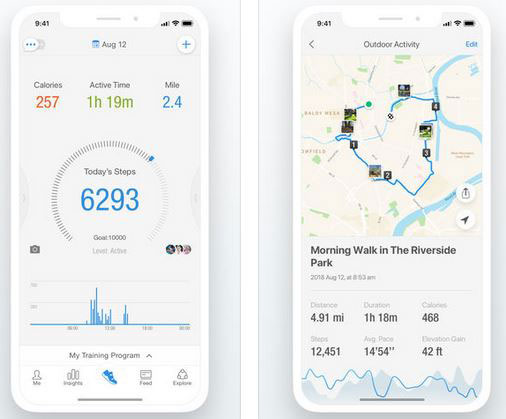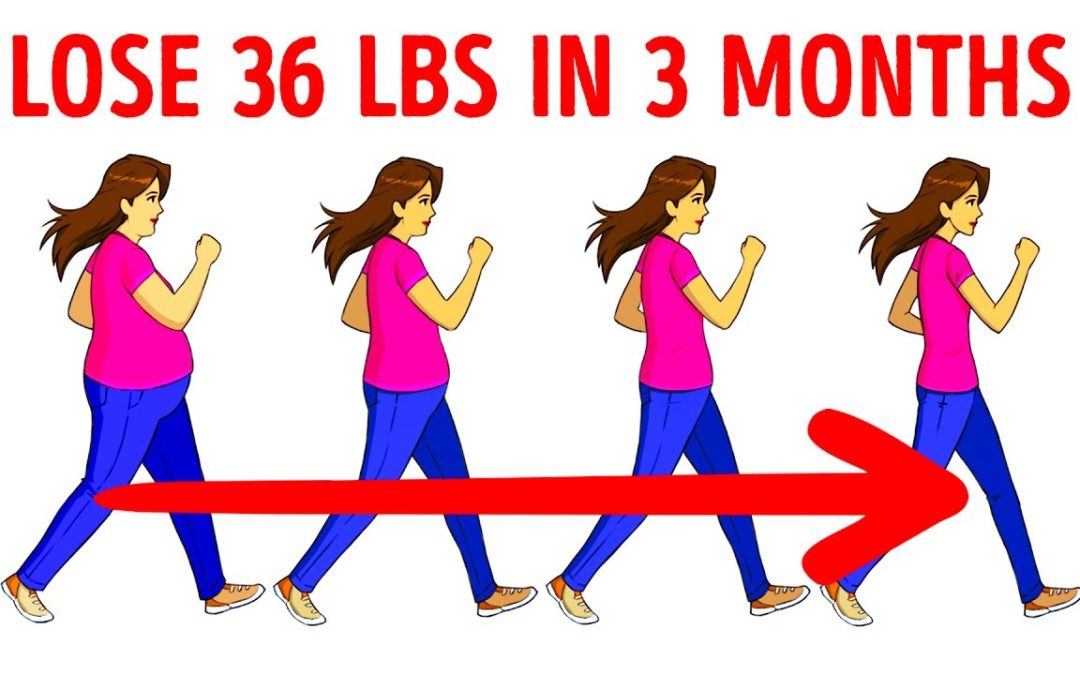I remember once asking my doctor what kind of exercise she recommends for her patients.
Her answer, “walking.”
Honestly, I was surprised. Of all the kinds of exercises you see health and fitness experts talk about, walking would be the last thing on my mind.
A few years and many miles later, I totally agree.
Walking is great. Almost anyone can do it no matter what your current fitness level is.
It is low impact, so you don’t jar your joints. And, there’s minimal risk of getting injured in the process.
Finally, if you know how to walk regularly, it’s a great way to lose and maintain weight.

Can I Lose Weight by Just Walking?
Simply answer: Yes!
According to a study published in the Journal of Nutrition, walking 3 hours per week (26 mins/day) helps you lose more weight than not walking.
More importantly, there was a significant reduction in their body fat compared to non-walkers.
Walking Burns Belly Fat
Similarly, another study found that obese women who walked between 50 and 70 minutes thrice a week for 12 weeks lost 1.1 inches from their waistlines and 1.5% of body fat.
Belly fat or fat stored around your midsection has is linked to higher risk of heart disease and diabetes.
This means who whose waistlines are over 40 inches and women who have waist circumferences over 35 inches are at increased risk.
Walking Also Improves Blood Pressure, Blood Sugar and Cholesterol
In addition to losing weight and belly fat, walking also offers other health benefits. Studies show that regular walking helps lower blood sugar and blood pressure.
Also, it helps reduce your risk of high cholesterol and triglycerides as well.
Chew Gum While Walking to Boost Weight Loss
Strange enough, chewing gum while you walk seems to help increase the weight loss effects of walking.
According to a study in The Journal of Physical Therapy Science, chewing gum increases your heart rate as your walk. This allows you to burn more calories.
Also, the researchers observed that chewing gum somehow boosts the distance and number of steps taken by the participants. Thus, further increasing the number of calories burned.
Scientists believe that chewing gum while causes “cardio-locomotor synchronization.” It is a natural phenomenon where our heart beats in rhythm with a repetitive movement, in this case, the chewing motion. Thus, causing it to beat faster.
How Many Calories Do You Burn Walking?
Including 30 minutes of brisk walking a day lets you burn about 150 more calories. To shed a pound a week, you generally need to cut back 500 calories a day.
Walking allows you to burn between 100 to 300 calories every 30 minutes. How many calories you end up burning will depend on a few factors, among them are:
- Your weight
- Your metabolism
- Walking intensity
In general, the more you weigh, the quicker you lose weight. Similarly, the faster your body’s metabolism, the more calories it burns. And, as you increase your walking speed, you’re more likely to shed more pounds.
As a start, try to target 2.5 to 3 mph which is considered brisk walking.
How Much Do You Have to Walk to Lose Weight?
The American Heart Association recommends getting 150 minutes of moderate intensity exercise per week. This totals about 21 minutes per day.
That’s an excellent place to start.
But, if your goal is to lose weight and burn fat, you’ll need to do more. Here’s why.
When you walk 30 minutes or more, you burn not only calories but also some of your stored fats. The latter helps improve body composition which has been shown to be vital to good health.
Walking for 30 minutes or less will help you shed pounds. It’s important to note that during this time, your body mostly burns sugars (glucose) which it uses for energy.
By the 30-minute mark, your sugar stores are used up.
This forces your bodies to turn to other fuel sources it has stored up through time. The first one it uses is fat.
Your body releases fat (the stored energy) from your fat cells to use as fuel.
This is why it’s important to build up to walking endurance. By walking more than 30 minutes at a time, you’re able to burn more fat and not just calories.
Don’t forget; it’s essential to keep a brisk pace. Walking 30 minutes or more slowly isn’t going to help.
- The goal is to do at least 100 steps per minute (3,000 steps total).
- Or, if you prefer using distance, 30 minutes of brisk walking is around 1.5 to 2 miles.

How Often Should You Walk?
We recommend stating slowly and working your way up to 30-60 minutes per day.
Make sure to listen to your body and slowly add steps on a daily or weekly basis depending on what your body is telling you. Remember, the goal isn’t to walk as far as you can as soon as possible.
Instead, your goal is to make walking a lifestyle, so it helps you lose weight. And, just as importantly, let you maintain your new weight.
It’s important not to overwork yourself because doing so only hampers your ability to be consistent in the long run.
If you aren’t sure how to get started, check out our walking for weight loss programs below. We’ve included a beginner (couch potato) program and an intermediate program.
To avoid getting bored try different things.
If you walk outdoors, try taking different routes every week. This lets you explore places as you shed the pounds.
If you use a treadmill, try out different programs, watch television or listen to music. These things will help pass the time and change things up.
How to Walk for Weight Loss (The Right Way)
1. Check with Your Doctor First
Before starting any type of exercise, make sure to check with your doctor first.
Sure, it’s just walking. We do it every day.
But, there’s a difference between walking for 2-5 minutes at a time and walking for 20-30 minutes at a time.
This becomes more important if you have any existing conditions like hypertension, diabetes or history of heart issues.
Staying in touch with your doctor also helps in case you experience any symptoms during your workouts. These can include dizziness, dehydration, overexertion, soreness or swelling.
2. Get the Right Gear
There’s no need to be fancy here. You don’t need to go out and spend money on athletic gear.
But, having a durable pair of comfortable sneakers is a good start. You can use almost any old pair you have.
A good pair of sneakers lets you walk comfortably for 30-60 minutes without any pain or soreness. It is also stable enough so you don’t turn or twist your ankle on uneven surfaces.
For the most part a comfortable, shirt or top works well. Try to wear one that isn’t too tight and is breathable. This lets you move freely and allows for ventilation.
If you sweat a lot, we recommend going with something that’s moisture wicking. This helps keep the sweat off your body.
Finally, wear gear that’s weather appropriate. If there’s a light drizzle, try brining a hoodie or cap to keep you from getting wet.
3. Figure Out How Many Steps You Make in a Mile
You can do this manually, use a pedometer or a fitness tracker.
It’s important to do this yourself and not base it on other people’s counts. That’s because everyone’s stride (and stride length) is different.
Your goal in this part is to be able to measure how much walking you’re doing on a daily basis. You can do so in a few ways.
- Total duration – by counting the total number of minutes. This requires keeping a certain pace. Otherwise, you could end up walking very little distance in a long time.
- Total distance – counting how many miles per day. This requires known how many steps you take in a mile. Or, how long it takes for you to walk a mile.
- Total steps – this is done by counting the total number of steps you’ve taken. This requires keeping track of intensity, usually by counting the number of steps per minute or finishing the steps in a specific amount of time.
In all of the cases, your goal is to try to walk at least 2.5-3 mph which is the speed for brisk walking. This allows you to burn calories and fat.
4. Figure Out Your Starting Point
Your baseline is how many steps you take on a daily basis. This will give you an idea of the amount of walking you’re used to, making it a good starting point.
An excellent way to achieve this is to take a pedometer or fitness tracker. These apps will let you count the total number of steps you make per day.
Try to go about your day as you usually would. Doing so lets you get an honest and accurate baseline.
For example,
- Day 1: 2,500 steps
- Day 2: 1,400 steps
- Day 3: 2,220 steps
This gives you an average of 2,033 steps as your baseline starting point.

5. Pick the Right Walking Program for Your Fitness Level
While getting off the couch and walk can help you lose weight, following a structured program helps you get better results. It also allows you to ramp up duration and intensity gradually. This way, you don’t overexert yourself.
Here are a couple of walking programs provided by MyFitnessPal. Both are 30-day walking programs with 10,000 steps as their goals.
- Beginner program (for couch potatoes)
- Intermediate program (for those who have more experience)
Why 10,000 Steps?
Ten thousand steps offer a good balance. It is something everyone can do. And, it provides many health benefits. Studies show that walking 10,000 steps a day improves weight, body composition, cholesterol, blood pressure and blood sugar.
It is also a great alternative to 30 minutes of day of exercise.
Because we all walk every day, it’s much easier to incorporate this type of exercise into our lifestyle since we’re only taking more steps.
Beginner Walking Program to 10,000 Steps
This program starts with a goal of 2,000 steps. At about 100 steps per minute, that’s a total of 20 minutes for the entire 2,000 steps on day 1.
You can likewise break the total down to four 5-minute walking sessions, where you take 500 steps each session.
The program adds 500 steps on most days. It also includes rest days to allow you to adjust.
Intermediate Walking Program to 10,000 Steps
If you’re already doing some regular walking, then this is a better program to try.
Like the beginner couch potato program, it aims to reach 10,000 steps a day. The difference is, you begin at 5,000 steps on the first day.
Again, you can break the total number of steps into 5 or 10-minute sessions.
What if You Can’t Walk for 30 Minutes Straight?
If you aren’t able to walk for 30 minutes at a time, try breaking it down into smaller chunks.
It’s often much easier to walk 10 minutes 3 times a day. For example, walking 10 minutes after each meal makes it easy to remember. Plus, you get the added benefit of lower blood sugar as the exercise helps burn glucose from digested food.
Also, don’t forget to warm up for 5 minutes before going on your 30-minute walk. Walking at a relaxed pace or marching in place helps your body get ready for the more extended session.
A true love for sports


Recent Comments